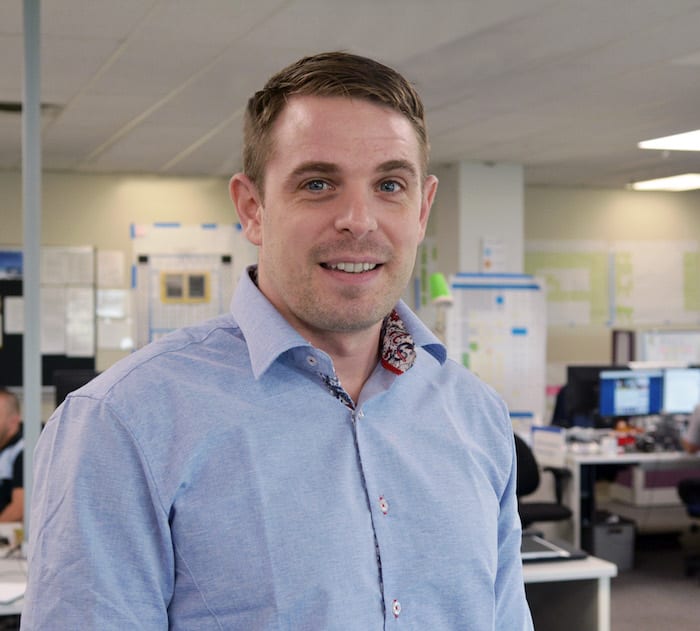
Adam Nelson, engineering manager of aircraft information systems at Esterline CMC Electronics. Photo courtesy of Esterline CMC Electronics
Adam Nelson’s experience playing and coaching hockey in high school and college still shapes the way he approaches his role today as a cockpit systems integration avionics engineer. The engineering manager of aircraft information systems for Esterline CMC Electronics told Avionics International he sees commercial flight operations becoming increasingly data centric into the 2020s.
Nelson has master’s degrees in engineering design and management as well as an electrical engineering bachelor’s degree from the University of Wisconsin-Platteville, where he also coached hockey for nine seasons.
Today he manages the avionics engineering division of Esterline that developed the aircraft information server featured on the Airbus A220, which recently entered into service for Delta Air Lines.

Cockpit of the Airbus A220, which features Esterline CMC’s aircraft information server as standard production equipment. Photo courtesy of Airbus
How did your career path bring you to Esterline CMC Electronics?
Prior to graduating, I interned at Esterline AVISTA in Platteville, Wisconsin, for one year, and then upon graduation I moved into a full-time position. My first position at AVISTA was within the test engineering department, which was responsible for designing and developing all the test equipment (hardware and software) that assisted in the testing of avionics software.
Right around a year after I started, I was promoted to the lead of the test engineering group. I spent a lot of time out at another sister company, Esterline Korry Electronics in Seattle, Washington, working on test equipment for Boeing 787 flight deck control panels. I was promoted to engineering manager in 2014 and spent the next few years focusing on improving culture, engineering capabilities and ensuring the company objectives are met.
I would never have been interested in engineering management if I weren’t able to coach college hockey. The ability to coach, mentor, teach, etc. and see objective improvement is a feeling you’ll never be able to express in words.
What inspired you to get into aerospace engineering?
Ever since I was a child, I have always loved airplanes. You start out with this basic understand of “metal is heavy and there is no reasonable explanation for this to be able to fly,” and eventually you start to understand how and why, and it’s phenomenal.
Additionally, once you start to understand the evolution of airplanes and what’s actually going on inside your mind gets blown for a second time.
What are your day-to-day schedule and responsibilities?
My day to day schedule is usually broken down into a few activities:
- What does my team need to be successful? All the way from answering a technical question down to the minutia of finding post-its. This is my primary responsibility as an engineering manager: making sure my team as everything they need to be successful and aggressively breaking down roadblocks for them to achieve their success.
- Working with the program/product teams and customers to ensure that expectations and priorities are aligned. This usually happens between a few program reviews, bid/proposal meetings, product roadmap discussions, etc. Realistically, the question I try to get answered is, “What is the feature set that needs to be worked next sprint?”
- Beyond the reactive ways to make the team more successful, how can I see into the future and lay the groundwork for things like:
- What can I do to grow the team by external means? This could be either outside hires or partnerships with local universities or businesses.
- Keeping an ear to the ground for customer requirements in current or future projects.
- Monitoring new technologies, industry standards, working groups, subcommittee meetings, etc. that will help grow the product line.
It’s usually a jam-packed day. Four o’clock rolls around, and typically I’m left asking, “Where did the day go?”
Have you experienced any challenges in achieving certification for new and innovative Esterline CMC connectivity solutions?
Fortunately, we haven’t yet run into any major certification problems. We are all in a new domain — something that hasn’t existed until recently. I think all the certification authorities are still playing catchup and looking for help from suppliers to identify what they really need to care about. The name of the game right now is agility. This is a concept, especially around aircraft certification, that is not appreciated enough.
What do you see as the next major capability or solution that Esterline will be developing in the future?
I think most of the companies out there have figured out ways to aggregate and, in some cases, offload the data for their customers. In five years, it’s going to be about partnering with your customers to help them get the most from their data, helping them adjust what’s currently on the plane to harvest new/different data to meet their business needs five years from now without major STCs. IT devices on-wing are going to explode along with various other sensors that can monitor things like how full the overhead bins are.
I expect the short to medium term will be about reducing maintenance costs and shifting from the reactive maintenance model to the preventative maintenance model: How can we find problems before they are problems? After that, you’re probably looking at how to optimize fuel consumption and reduce other costs in-flight — that’s where the fun begins.